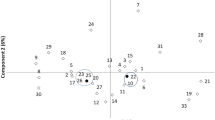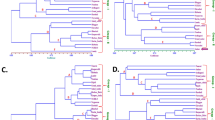Abstract
Stevia rebaudiana (Bertoni) Bertoni is a widely grown species in various regions of the world, mainly due to its sweetening properties attributed to steviol glycosides. Despite the fact that Paraguay is the center of origin of S. rebaudiana, genetic characterization of local genotypes has not been studied. Considering that accumulation of steviol glycosides is a complex trait, molecular breeding could be an effective method for its improvement. Therefore, the identification of molecular markers associated with steviol glycoside accumulation is important. The aim of this study was to assess the genetic relationship among eight advanced lines of S. rebaudiana and two varieties selected from local germoplasm and quantify their steviol glycoside content. The stevioside and rebaudioside A content in methanolic extract was determined by high-performance liquid chromatography (HPLC), and the molecular characterization of the ten genotypes of S. rebaudiana was performed using SSR and ISSR markers. A wide range of variability was observed for the metabolites of interest under greenhouse conditions. The variety Eirete presented highest stevioside and rebausiode A content, followed by the variety Katupyry. One of the advanced line presented both metabolite content similar to that of Katupyry. Genotyping of these lines showed two main clusters. Cluster I contained the both varieties and advanced lines with higher stevioside and rebaudioside A content. Our results suggest that S. rebaudiana lines with genetic profile similar to that of cluster I, determined mainly by genotype at the markers SUGMS 35 and ISSR 47, might present higher stevioside and rebaudioside A content.

Similar content being viewed by others
References
Abdelsalam NR, Botros WA, Khaled AE, Ghonema MA, Hussein SG, Ali HM, Elshikh MS (2019) Comparison of uridine diphosphate-glycosyltransferase UGT76G1 genes from some varieties of Stevia rebaudiana Bertoni. Sci Rep 9(1):8559. https://doi.org/10.1038/s41598-019-44989-4
Bhandawat A, Sharma H, Nag A, Singh S, Ahuja PS, Sharma RK (2014) Functionally relevant novel microsatellite markers for efficient genotyping in Stevia rebaudiana Bertoni. J Genet 93:75–81. https://doi.org/10.1007/s12041-014-0406-8
Botstein D, White RL, Skolnick M, Davis RW (1980) Construction of a genetic linkage map in man using restriction fragment length polymorphisms. Am J Hum Genet 32(3):314–331
Casaccia J, Britos R, Bozzano G, Sanabria A, Cantero F (2016) Variedades de Ka’a he’ẽ /stevia. In: Britos R, Park J (eds) Ka’a he’ẽ Stevia rebaudiana (Bertoni) Bertoni: La dulce planta de Paraguay para el mundo, alternativa para la diversificación de la finca. IPTA-KOPIA, Caacupé, pp 25–32
Ceunen S, Geuns JMC (2013) Steviol glycosides: chemical diversity, metabolism, and function. J Nat Prod 76:1201–1228. https://doi.org/10.1021/np400203b
Chester K, Tamboli ET, Parveen R, Ahmad S (2013) Genetic and metabolic diversity in Stevia rebaudiana using RAPD and HPTLC analysis. Pharmaceutical biology 51(6):771–777. https://doi.org/10.3109/13880209.2013.765898
Cosson P, Hastoy C, Errazzu LE, Budeguer CJ, Boutié P, Rolin D, Schurdi-Levraud V. 2019. Genetic diversity and population structure of the sweet leaf herb, Stevia rebaudiana B., cultivated and landraces germplasm assessed by EST-SSRs genotyping and steviol glycosides phenotyping. BMC Plant Biol. 19(1):436. https://doi.org/10.1186/s12870-019-2061-y
Doyle JJ, Doyle JL (1990) Isolation of plant DNA from fresh tissue. Focus 12:13–15
Dyduch-Siemińska M, Najda A, Gawroński J, Balant S, Świca K, Żaba A (2020) Stevia Rebaudiana Bertoni, a source of high-potency natural sweetener-biochemical and genetic characterization. Molecules 25(4):767. https://doi.org/10.3390/molecules25040767
Gantait S, Das A, Banerjee J (2018) Geographical distribution, botanical description and self-incompatibility mechanism of genus Stevia. Sugar Tech 20:1–10
Gomes EN, Moterle D, Biasi LA, Koehler HS, Kanis LA, Deschamps C (2018) Plant densities and harvesting times on productive and physiological aspects of Stevia rebaudiana Bertoni grown in southern Brazil. An Acad Bras Cienc 90(4):3249–3264. https://doi.org/10.1590/0001-3765201820170510
González A, Moralejo S (2011) Aproximación a la comprensión de un endulzante natural alternativo, la Stevia rebaudiana Bertoni: producción, consumo y demanda potencial. Agroalimentaria 17(32):57–69
Hammer O, Harper DAT, Ryan PD (2001) Past: paleontological statistics software package for education and data analysis. Palaeontol Electron 4(1):9
Hastoy C, Cosson P, Sclaunich E, Jannot P, Boutié P, Rolin D, Schurdi-Levraud V. 2015. Stevia: Growth in knowledge and taste towards breeding of new Stevia rebaudiana cultivars adapted to organic production in the south west of france: first results on genetic and phenotypic evaluation. In: Ceunen S, Geuns JMC (eds) Proceedings of the 8th Stevia symposium of European Society of Stevia (EUSTAS) EUSTAS, Bonn, pp 225–232
Heikal AH, Badawy OM, Hafez AM (2008) Genetic relationships among some Stevia (Stevia rebaudiana Bertoni) accessions based on ISSR analysis. Res J Cell Mol Biol 2(1):1–5
Hildebrand CE, Torney DC, Wagner RP (1994) Informativeness of polymorphic DNA markers. In: Cooper NG (ed) The human genome project: deciphering the blueprint of heredity. Los Alamos Science, Mill Valley, pp 100–102
Jiménez T, Cabrera G, Álvarez E, Gómez, F. 2010. Evaluación del contenido de esteviósido y rebaudiósido A en una población de Stevia rebaudiana Bertoni (kaâ heê) cultivada comercialmente. Estudio preliminar. Mem. Inst. Investig. Cienc. Salud. 8(1): 47–53
Joint FAO/WHO Expert Committee on Food Additives [JECFA] (2016) FAO JECFA Monographs 19: Compendium of Food Additive Specifications.
Kaur R, Sharma N, Raina R (2015) Identification and functional annotation of expressed sequence tags based SSR markers of Stevia rebaudiana. Turk J Agric For 39:1–12. https://doi.org/10.3906/tar-1406-144
Khan SA, Rahman LU, Shanker K, Singh M (2013) Agrobacterium tumefaciens mediated transgenic plant and somaclone production through direct and indirect regeneration from leaves in Stevia rebaudiana with their glycoside profile. Protoplasma 251(3):661–670. https://doi.org/10.1007/s00709-013-0568-x
Kujur A, Saxena MS, Bajaj D, Laxmi PSK (2013) Integrated genomics and molecular breeding approaches for dissecting the complex quantitative traits in crop plants. J Biosci 38(5):971–987. https://doi.org/10.1007/s12038-013-9388-6
Martínez D, Rojas L, Urreal A, Jiménez E, Monsalve ZI (2007) Caracterización genómica mediante AFLP de Stevia rebaudiana Bertoni cultivada en el departamento de Antioquia (Colombia). Biotecnol Vegetal 7(2):107–113
Petit E, Jacques A, Daydé J, Vallejo V, Berger M (2019) UGT76G1 polymorphism in Stevia rebaudiana: New variants for steviol glycosides conjugation. Plant Physiol Biochem 135:563–569. https://doi.org/10.1016/j.plaphy.2018.11.002
Petolescu C, Lazar A, Petrescu I, Ioja-Boldura OM, Velicevici G, Banu C (2011) Somaclonal variation at the nucleotide sequence level revealed by RAPD and ISSR markers. J Horticult Forestry Biotechnol 15(4):119–123
Powell W, Morgante M, Andre C, Hanafey J, Vogel S, Tingey A, Rafalski A (1996) The comparison of RFLP, RAPD, AFLP and SSR (microsatellite) markers for germplasm analysis. Mol Breeding 2:225–238. https://doi.org/10.1007/BF00564200
Prakash I, DuBois GE, Clos JF, Wilkens KL, Fosdick LE (2008) Development of rebiana, a natural, non-caloric sweetener. Food Chem Toxicol 46(7):S75–S82. https://doi.org/10.1016/j.fct.2008.05.004
Samuel P, Ayoob KT, Magnuson BA, Wölwer-Rieck U, Jeppesen PB, Rogers PJ, Rowland I, Mathews R (1205S) Stevia leaf to stevia sweetener: exploring its science, benefits, and future potential. J Nutr 148(7):1186S–1205S. https://doi.org/10.1093/jn/nxy102
Schauer S, Huang T, Samuel P, Khazi F, Markosyan A (2017) Insights from the sequencing and annotation of the Stevia rebaudiana genome and their application in agronomy and health. Ann Nutr Metab 71(Suppl 2):1316–1317
Shirwaikar A, Parmar V, Bhagat J, Khan S (2011) Identification and estimation of stevioside in the commercial samples of Stevia leaf and powder by HPTLC and HPLC. Int J Pharmacy Life Sci 2(9):1050–1058
Soejarto D (2002) Botany of Stevia and Stevia rebaudiana. In: Kinghorn A (ed) Stevia: The genus Stevia. Taylor and Francis London, New York, pp 18–39
Soejarto DD, Addo EM, Kinghorn AD (2019) Highly sweet compounds of plant origin: From ethnobotanical observations to wide utilization. J Ethnopharmacol 243:112056. https://doi.org/10.1016/j.jep.2019.112056
Subositi D, Sri R, Daryono BS (2011) Genetic diversity of stevia (Stevia rebaudiana (Bertoni) Bertoni) based on molecular characters. Proceeding 1(1):37–41
Tateo F, Mariotti M, Bononi M, Lubian E, Martello S, Cornara L (1998) Stevioside content and morphological variability in a population of Stevia rebaudiana (Bertoni) Bertoni from Paraguay. Ital J Food Sci 10(3):261–267
Tavarini S, Sgherri C, Ranieri AM, Angelini LG (2015) Effect of nitrogen fertilization and harvest time on steviol glycosides, flavonoid composition, and antioxidant properties in Stevia rebaudiana Bertoni. J Agric Food Chem. 63(31):7041–7050. https://doi.org/10.1021/acs.jafc.5b02147
Wu Q, La Hovary C, Chen HY, Li X, Eng H, Vallejo V, Qu R, Dewey RE (2020) An Efficient Stevia rebaudiana transformation system and in vitro enzyme assays reveal novel insights into UGT76G1 function. Sci Rep. 10(1):3773. https://doi.org/10.1038/s41598-020-60776-y
Yadav S, Guleria P (2012) Steviol glycosides from stevia: biosynthesis pathway review and their application in foods and medicine. Food Science and Nutrition 52:988–998. https://doi.org/10.1080/10408398.2010.519447
Yang YH, Huang SZ, Han YL, Yuan HY, Gu CS, Zhao YH (2014) Base substitution mutations in uridinediphosphate-dependent glycosyltransferase 76G1 gene of Stevia rebaudiana causes the low levels of rebaudioside A: mutations in UGT76G1, a key gene of steviol glycosides synthesis. Plant Physiol Biochem 80:220–225. https://doi.org/10.1016/j.plaphy.2014.04.005
Yang Y, Huang S, Han Y, Yuan H, Gu C, Wang Z (2015) Environmental cues induce changes of steviol glycosides contents and transcription of corresponding biosynthetic genes in Stevia rebaudiana. Plant Physiol Biochem. 86:174–180. https://doi.org/10.1016/j.plaphy.2014.12.004
Yasuda N (1988) HLA polymorphism information content (PIC). Jpn J Human Genet 33:385–387. https://doi.org/10.1007/BF02032870
Zhang SS, Chen H, Xiao JY, Liu Q, Xiao RF, Wu W (2019) Mutations in the uridine diphosphate glucosyltransferase 76G1 gene result in different contents of the major steviol glycosides in Stevia rebaudiana. Phytochemistry 162:141–147. https://doi.org/10.1016/j.phytochem.2019.03.008
Acknowledgements
This research was supported by Consejo Nacional de Ciencia y Tecnología (CONACYT) of Paraguay (Grant number 14-POS-004 and 14-INV-450) and Instituto de Biotecnología Agrícola (INBIO). Authors would like to thank Nidia Benítez for English translation of the manuscript.
Author information
Authors and Affiliations
Corresponding author
Ethics declarations
Conflict of interest
The authors declare that they have no conflict of interest.
Rights and permissions
About this article
Cite this article
Bogado-Villalba, L., Nakayama Nakashima, H., Britos, R. et al. Genotypic characterization and steviol glycoside quantification in a population of Stevia rebaudiana Bertoni from Paraguay. J. Crop Sci. Biotechnol. 24, 145–152 (2021). https://doi.org/10.1007/s12892-020-00066-1
Accepted:
Published:
Issue Date:
DOI: https://doi.org/10.1007/s12892-020-00066-1




